June 2, 2025 | 03:30 GMT +7
June 2, 2025 | 03:30 GMT +7
Hotline: 0913.378.918
June 2, 2025 | 03:30 GMT +7
Hotline: 0913.378.918
“In the past, we have rooted out and even dealt with substandard growing areas, but we failed to get the desired results. With the current strict requirements from the Chinese market, everything will have to change by itself for the better, the market will regulate the supply", said Assoc. Prof. Dr. Nguyen Minh Chau, former director of the Southern Horticultural Research Institute.
However, Dr. Chau also warned about the dangers of "spontaneous" durian farming . He said that the state needs to cooperate with scientists and farmers to study, conduct field surveys, and learn thoroughly to identify the strong durian growing areas.
“I am not too worried about the capacity of Vietnamese farmers, but we have to be very careful about growing durians indiscriminately and spontaneously. We have already grasped the fundamental knowledge regarding potential growing areas. If we plan to develop new growing areas outside the South and Central Highlands, it is necessary to have the participation of scientists and farmers”, said Dr. Chau.
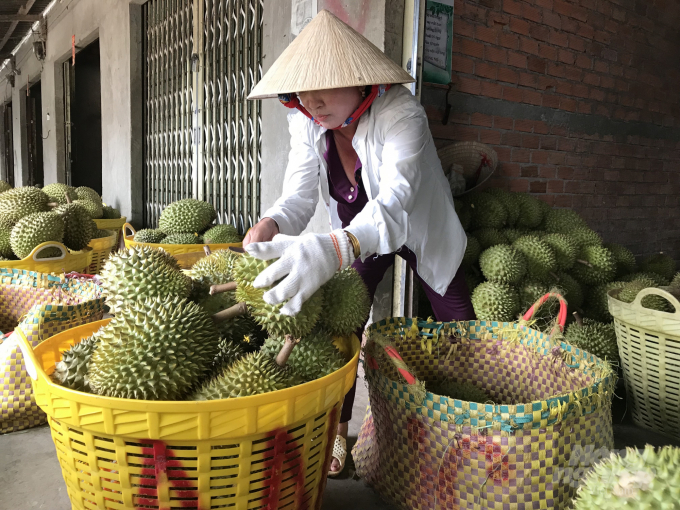
Most durians are currently consumed through the local traders system. Photo: Van Viet.
The area to the north of National Highway 1A crossing the districts of Cai Lay, Cai Be, Tan Phuoc and Cai Lay Town (Tien Giang) was originally planned for rice cultivation, but farmers have found it more profitable to grow durian so a few sporadic households chose to grow durian.
According to Dr. Chau, it is very difficult to rely on administrative measures to resolve this issue. He said that farmers should still be allowed to grow durians in this areas to increase their income, but they must ensure the process so as not to affect the reputation of Cai Lay durian.
Mr. Nguyen Van Man, Director of Tien Giang Department of Agriculture and Rural Development shares a similar opinion. He had surveyed spontaneous durian growing areas outside the provincial development plan and found that: “In My Tan commune, Cai Be district, durian boasts excellent growth. However, durians grown in My Thanh Nam and My Thanh Bac, Cai Lay districts are still lacking.
Most notably, most durian farmers in Tan Phuoc area suffer from losses. After 3 years, durian gradually dries out and goes to waste. Regarding the quality of the durian, I have also encountered cases of dry, flat and substandard durian. Durians turn yellow leaves after 2 to 3 years of growing, and although the trees do not die, farmers still suffer heavy losses. The cost of growing durian is very high; it is such a waste to lose that money if the trees die within 2 to 3 years of growing", worried Mr. Man. He plans to organize a workshop to review the province's durian development project as well as to receive advice from scientists on planting and caring techniques for this crop.

Farmers in the Mekong Delta have experience in durian production and intensive cultivation. Photo: Minh Dam.
In addition to growing durian in the main season and looking forward to ripe durians from April to November along the latitudes from the Southwest, the Southeast to the Central Highlands, Dr. Chau places his trust in the capacity and experience of farmers with off-season durian.
“The market itself will regulate the prices. The off-season durian price is currently higher, but it is impossible to say for sure that this trend will remain. With the Vietnamese climate and soil conditions, off-season durian growing is completely viable. In reality, farmers have grown a lot of off-season durians. What we need to be concerned about here is the fact that the fertilizing stage must be professionalized, avoiding illegal measures for personal gains", emphasized Dr. Chau.
Durian growing areas in Vietnam mostly utilize the Mongthong and Ri6 varieties. Namely, the Ri6 durian variety (accounting for nearly 55% of the durian growing area) is the key strength of Cai Lay district, Tien Giang.
“If saltwater intrusion can be controlled and the plants are protected from salinity, the quality of Ri6 durian will be better. When eaten, the taste is also sweeter, not "hard" like some other durian varieties that are heavy on yield," shared Mr. Huynh Tan Loc, Director of Ngu Hiep Durian Cooperative in Cai Lay.
Scientists and farmers both expressed their expectations for the opportunity to professionalize the fertilizing, harvesting, and preliminarily processing of durian from the opportunity to officially export to the Chinese market. Dr. Chau and Mr. Man agreed that, the farmers will understand the benefits of organic farming more than anyone else even without promotion from the Government. With market regulation, everything will most likely flow in favor of the sustainable development of durian trees.
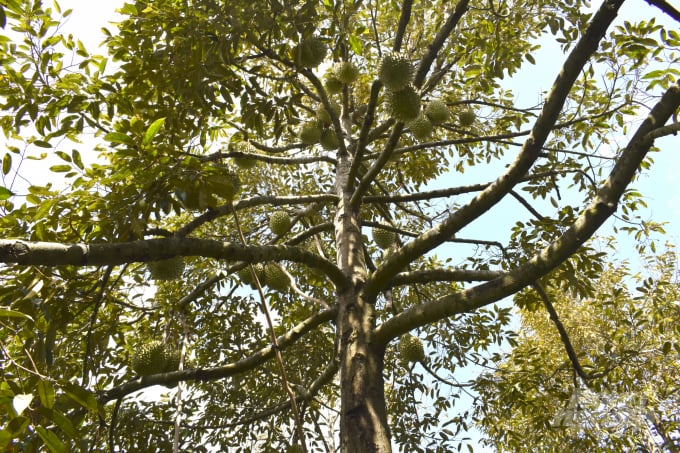
Durian is a highly profitable crop that motivates farmers to invest in production. Photo: Minh Dam.
At Chanh Thu Fruit Import Export Co., Ltd, the preparation of cold storage and freezing by nitrogen gas is readily available. Many packaging boxes with Chinese descriptions have also been prepared, waiting to be shipped to China.
Ngo Tuong Vy, Deputy Director of the company, said that Vietnamese durian currently only accounts for one-third of the Chinese market. "Vietnamese businesses need to unite, we should not compete with one another in the existing one-third market share, but instead, we need to work cooperatively to extend our reach to the remaining two-thirds" said Ms. Vy. Trading on the market is never an easy work, but Ms. Vy claimed that Chanh Thu Company can confidently "affirm the position of Vietnamese durian" in the Chinese market.
Sharing the experience of traveling through various Southeast Asian countries specializing in durian, Assoc. Prof. Dr. Nguyen Minh Chau said that he was interested in the durian experience tourism model. For example, Malaysian farmers organize tours for visitors to take care of trees, hang hammocks in the farms, and eat ripe fruits right on the field. “Not only does this help increase income, it is also the best possible durian promotion channel. Words would pass from mouth to mouth, then through posted photos and clips on social networks. The images of durian trees will reach further, even to markets that we did not anticipate”, said Dr. Chau.
According to Dr. Chau, in order to accomplish this, local governments need to socialize in attracting capital to build roads and bridges. With uniquely small and bumpy roads, many vehicles in the Southwest farms find it difficult to turn; so it is very important to upgrade the roads.
Farmer Huynh Tan Loc shares the same view, because the expansion of the road will also reduce the cost of intermediary transportation from small trucks to containers, or from small boats to large boats.
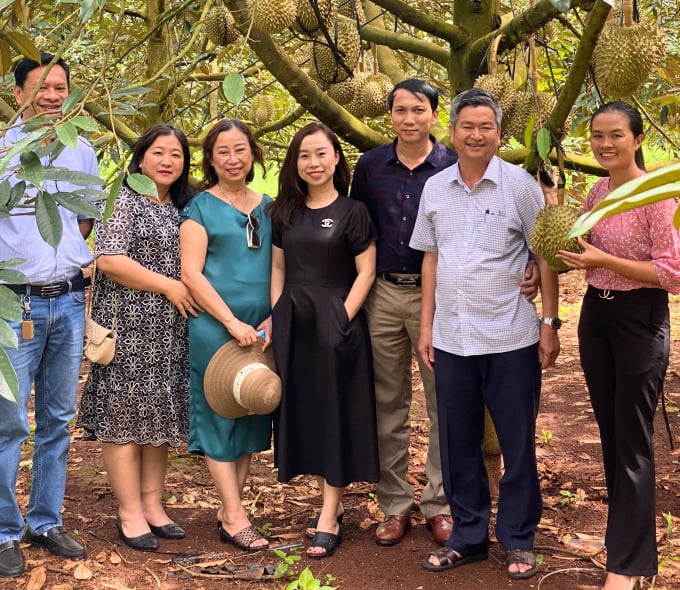
Utilizing agricultural tourism, along with investment in traffic improvement, will be a boost to our national durian production. Photo: MD.
“In addition to durian tourism experiences, the road expansion also helps visitors come to the farming areas of the West River. Our cooperative is ready to join the government", Mr. Loc affirmed.
The professionalization of durian production is a matter of great concern to the Ministry of Agriculture and Rural Development as well as Tien Giang province and farmers. High income from durian trees has prompted many farmers to boldly venture into production investment. However, for effective and sustainable development, farmers need to pay attention to technical solutions and production organization.
Mr. Nguyen Van Man, Director of Tien Giang Department of Agriculture and Rural Development, shared the problem of reorganizing durian production during the preliminary workshop on the province's durian development project: "Minister Le Minh Hoan has affirmed that we must reorganize durian production. Farmers must link together to form cooperatives. Tien Giang currently has 15 cooperatives specializing in durian production and consumption with 15,277 members, with 10 cooperatives in Cai Lay district and 1 in Cai Be district.
Activities of cooperatives and cooperative groups are always promoted and consolidated. Additionally, local goverments have implemented support policies such as infrastructure investment support policies. However, many difficulties remain: cooperatives have not developed strongly and played a core role.
Mr. Man said: “The improvement of plants and animals' quality must come from the farmers. To do that, farmers need to join cooperatives. We already have the process as transferred from the research of the Southern Horticultural Research Institute and the Department of Science and Technology. Therefore, it is necessary to organize training for farmers to improve uniformity from appearance to quality and safety of products."
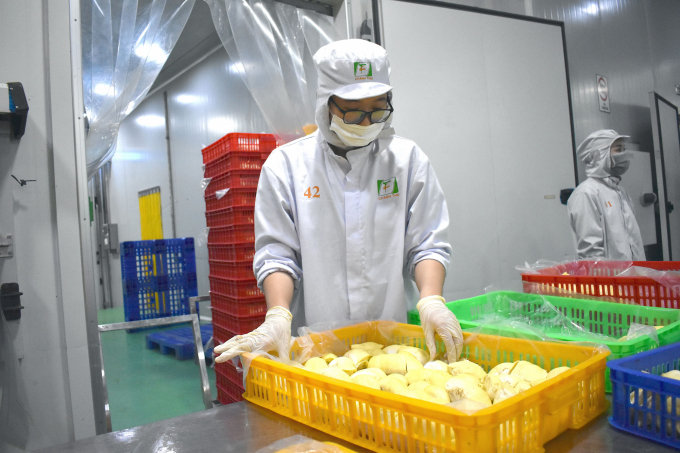
Improving durian's quality is a priority task according to current market requirements. Photo: Van Viet.
Eagerly awaiting Vietnamese durian
During an interview with the Vietnam Agriculture Newspaper, three independent Chinese durian importers said they were all excited about the official export of Vietnamese durians to this market.
"If a few years ago, most of the people who ate Vietnamese durian were from Guangxi and Guangdong, the northern market can now have an opportunity to know this special fruit. With Vietnamese businesses vacuuming and peeling durian in the farms as reported by the Vietnam Agriculture Newspaper, we are confident to transport the fruit to many places, in addition to the traditional market in Southern China", said one of the Chinese importer.
Mr. Luu Nam Tai, a representative of a fruit distribution business in Nanning (Guangxi, China) said that China has been importing durian mostly from Malaysia in the form of durian flesh in vacuum-sealed bags. With the Vietnamese exporters, Mr. Tai said that if the freezing stage is guaranteed, the distribution in China will face little problem.
“I have been working in this industry for over a decade, and I have never met a Chinese customer who complain about the smell of the durian fruit. A while ago, a Vietnamese business inquired me about this and I was quite surprised. I have personally been to Vietnam and I feel that durians are very delicious", said Mr. Luu.
Translated by Nguyen Hai Long

(VAN) Seafood by-products are opening a new path, combining green growth and technological innovation to enhance the industry's value.

(VAN) Mr. Nguyen Thanh Cong, Vice Chairman of the Son La Provincial People's Committee, reflects on Son La’s journey from barren hills to fruitful orchards after a decade of hard work.
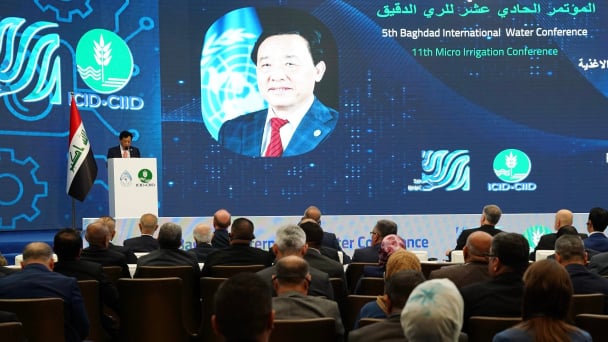
(VAN) FAO’s Director-General addresses the 5th Baghdad International Water Conference.
/2025/05/26/1716-4-nongnghiep-191706.jpg)
(VAN) Chain linkages, technological innovation, and raw material zoning are three strategic pillars for the coconut industry to strongly develop and elevate its position on the global agricultural map.
![Advanced mariculture – an inevitable trend: [4] Accompanied by scientists](https://t.ex-cdn.com/nongnghiepmoitruong.vn/608w/files/sohk/2025/05/13/1941-pgsts-vo-van-nha-140958_717.jpg)
(VAN) According to Assoc. Prof. Dr. Vo Van Nha, Director of the RIA III, the development of advanced offshore mariculture is no longer an option but an essential path for Vietnam’s fisheries sector.

(VAN) Vietnam is intensifying the development of mollusk farming areas that meet international standards, aiming for sustainable growth and enhancing its export position in the global seafood market.
![Advanced mariculture – an inevitable trend: [3] Policy-driven momentum](https://t.ex-cdn.com/nongnghiepmoitruong.vn/608w/files/doanhtq/2025/05/21/0104-0616-0348-nuoi-bien-170339_789.jpg)
(VAN) To ensure the success of offshore mariculture that uses advanced technologies, it is essential to establish supportive policies that inspire both individuals and enterprises to invest with confidence.